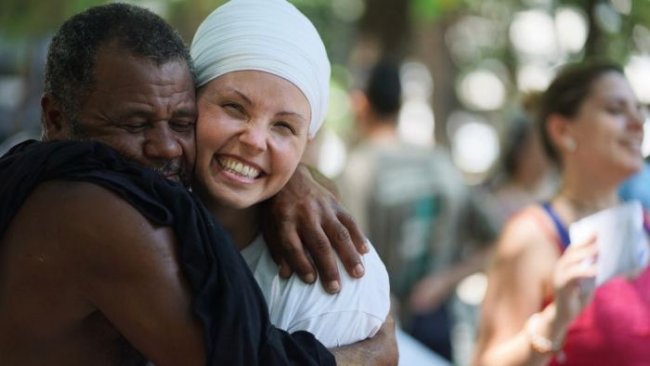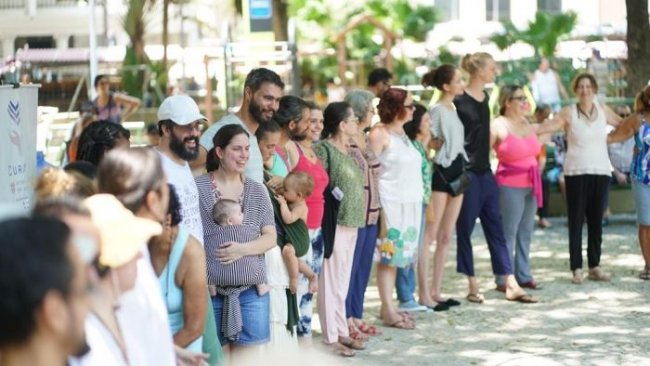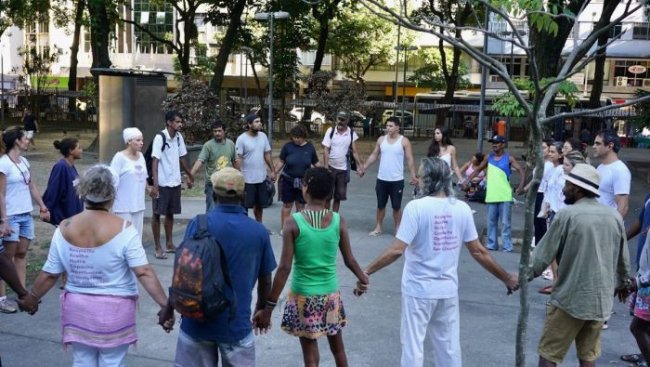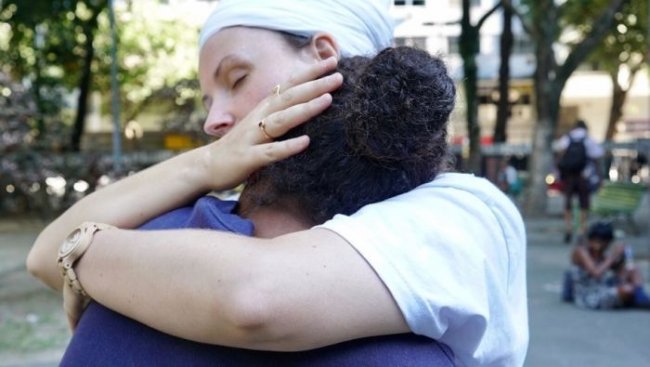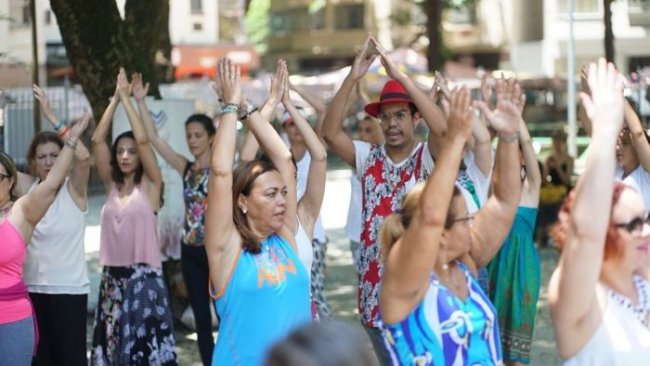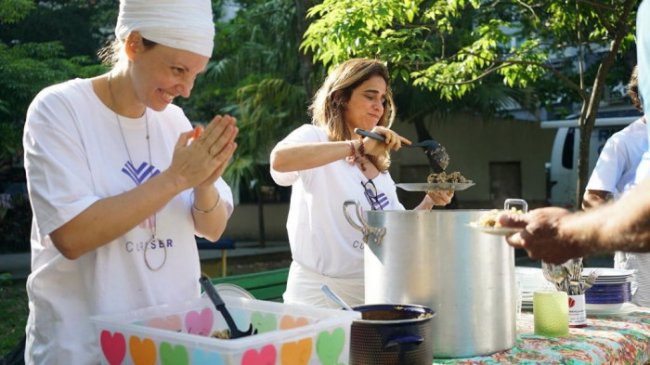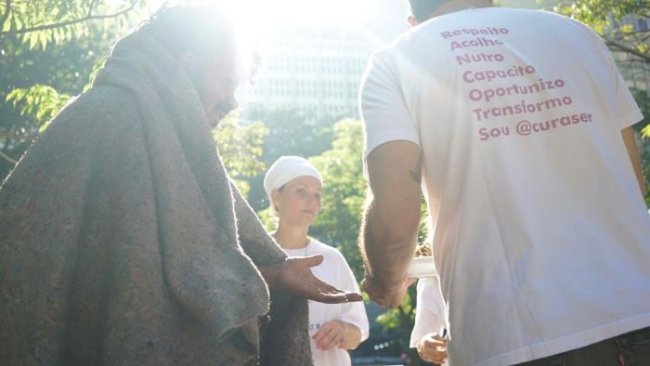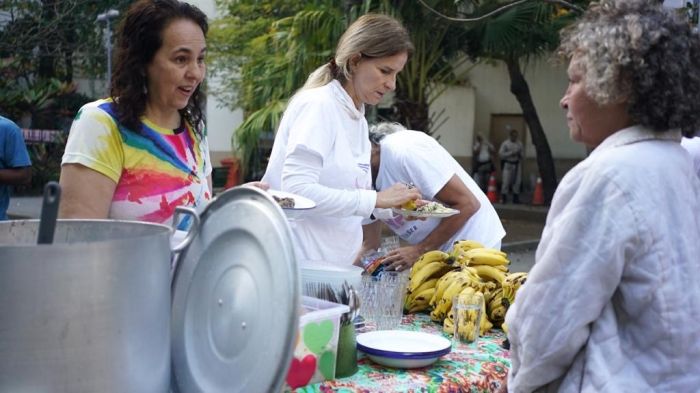Simrat Kaur – 'CURASER' (Brazil)
Can you describe the Seva you are doing?
I am based in Rio de Janeiro, Brazil. I am a doctor as a profession. I am involved in multiple projects. The mother of all these projects is Medicna da Consciencia – “medicine of awareness.” I founded this group. The goal is to bring consciousness to people. This project brings together a lot of tools for us to use for self healing, and disseminates these teachings in Rio de Janeiro – including Kundalini Yoga and Meditation.
I founded an NGO called CURASER – which means “healing self.” The project started about three years ago, and brings the social arm to Medicna da Consciencia’s efforts. Our goal is to bring transformation and self-healing, and bring people into awareness of their own selves. We started from a place of wanting to serve, and asking ourselves how we can serve with everything we have. What do we have to offer? Our love, our food. We join hands together.
We work with the homeless. We serve them Langar, teach yoga and meditation and engage in deep listening conversations. I am also serving in a project developed for children – we bring awareness of meditation and yoga into low income communities. I am working on developing some programs for schools too – to address reading development, and also to bring Kundalini Yoga teachers with KRI Level 1 training in to teach yoga to the students.
We are exploring the possibility of serving food to children in low income communities. This is a challenging process in Rio de Janeiro. We also hope to work with people being released from jail and prisons. This is another area we are exploring. We are also working on developing a free listening channel, where people can come and talk about their worries and fears during isolation. People are feeling really alone. This is something people can do. Just talk with people and do a meditation together, this is a really good Seva project for right now.
We began simply by going into the streets, and working with those who needed help there. Now with our new projects we are trying to bring transformation on a larger scale by working with communities in a more holistic way, and also expanding to working with new populations and communities.
We’re growing this community in Rio, and people are happy to serve and be together. This movement is growing and here to stay. It is going deeper with a big impact on society.
When people have their self-healing and transformation, they want to join together and be a part of something. They are joining together to make a movement here. People are doing beautiful projects with creativity in the arts, in social and relationship communication. We are spreading!
Can you offer advice and inspiration to those in the Sikh Dharma community who might like to do similar Seva in their own communities?
For me, one thing that usually happens is that when we go to our minds, and make a perfect or ideal project, and create all these strategies, we can get stuck.
Seva is really just you going there to help. If you start from there, the universe will take your hand and meet you there and go with you. People will come and join with you to bring a project to life, and things can start to grow. Don’t start only when you have everything all together, everything perfect. Start with something small.
Offering meditations and deep listening conversations are a big way to help people. When you start doing that, you can allow them to be part of something and open themselves. Then with this, penetrate this community and person you are healing. Then you are doing a project in partnership with the community you are helping, not by yourself. Start the project in partnership with the people you are trying to help.
Can you share 5 tips with our audience on how they can start their own Seva project?
See what you really can do right now. Not “something you want to do someday.” Being fixed on this ideal just leads to frustration. Be real, and see how you can manage to do something realistic for you right now, then you can go from there. Whether it’s once a week, or once a month. See what you can schedule – don’t compromise on the commitment, so start small.
Talk with someone who can give advice at the place you want to serve – this could be a school or hospital administrator, or a home care person. Introduce yourself and say you want to serve. People are usually so open to have someone serve them. Or try to approach another organization or NGO, and offer to do a yoga meditation class. Explore if if you can do this kind of project with partners.
Ask them what they need. And then, based on your time and schedule, and the feedback on what they need, join the two together and see how you can manage a program.
Make the commitment, of say, six months, 10 weeks, with this partner you identified and start there.
After that things can grow. You can bring someone with you and organize something bigger. Start small and grow bigger. Start with you, and take small steps.
Do you encounter any challenges when doing your Seva? How do you overcome them?
There are a lot of challenges, but the main thing is that we hold ourselves in this sense of Dharma that we have, and in serving. The challenges are mostly having the money to do it. Until now we’ve had donations. With every project, we have to ask for donations. This is a challenge, every time we have to go there.
Another challenge is commitment from volunteers. You have to have this engagement strategy to bring people in an elevated state to be part of this, together.
A third challenge is time – we are all trying to do a lot of things. To be organized, and to be able to execute everything, to manifest everything that we want to do is a challenge.
One thing we’re trying to do to address these challenges is create a more horizontal organizational style – with more people taking responsibility, and less pressure on the director as the center of the organization. This is very Aquarian. It’s a good strategy to do when you are trying to do Seva in organizations. We’re having people responsible for each project, and they are empowered to delegate responsibility and power to others.
Now that we are trying to do something with more impact in communities on a longer term basis, the challenge is to expand and manifest that. We are doing Seva with our hearts and trying to do our best. Everything is going the way the Divine wants us to do it. With more people, we can do more. This is the best way, a collective approach – to the organization and the Seva we are doing.
Do you draw inspiration from Sikh Dharma when doing Seva?
Guru Ram Das is in my heart – the Guru inspires me to just be open to serve. I think a lot of the humility of Guru Nanak, that brings us to relate to all people. We may be different but we are all one. Ek Ong Kar is there. When we are doing Seva in this mindset of Ek Ong Kar, so much transformation and healing can happen.
The people we work with are marginalized in society, and begin to feel a new connection and oneness during our programs. A healing process can start.
The Gurus are inspiring the way we are serving. The teachings are with us throughout the process. We are always remembering this. When we are preparing and serving langar, we do it with Japji Sahib and mantras playing, and this helps us connect. Sharing the mantras is beautiful because people just connect with the mantras and the sound and the Naad and want to be with us. People sense the high vibration of it. They receive the sounds of God. Even if they don’t know anything about it yet. It’s a beautiful thing to see and be part of.
Can you share a high moment or inspiring story that you experienced when doing Seva?
We work with people that are homeless. I have seen that first they are resistant to the programs, but once you are open and do deep listening together, they start to talk with their hearts. We have so many stories and have seen so many different healing processes. Some program participants have gone back to their families after 2-3 years of not going home. They go back and ask forgiveness. They are strong enough to go back.
Often they are ashamed to tell their families they were in this situation. After deep listening, conversations, and meditations, with our hands together with them, they were feeling stronger to go back home and say “I need you.” They often feel a lot of loneliness, but don’t go back because they are ashamed of themselves or the way they are living. They don’t want to come back with nothing for their families. A lot of people come to Rio to find a job to help their families. If they fail they sometimes start drinking, and end up on the streets. They can tie themselves in a big knot, and don’t go back home.
We have a number of examples of those who got reunited with their families. This is a big victory for us. We are inspired by their strength – they feel they are nothing at a certain point, but then they have the strength to pull themselves together and go back home.
This is a really inspiring thing, for people seeing this happen. Most of the volunteers who see that happen are seeing a big change. They have this big movement and transformation. Not everyone has it, but even for a few to have this change is huge.
Simrat Kaur
Simrat Kaur MD, is a doctor, Founder of Medicina da Consciência and president of the NGO CuraSer.
She is a Kundalini Yoga teacher, member of the Aquarian Academy, Sat Nam Rasayan practitioner and life poet.



